Don't Get the Wrong End of the Stick: Lifting the Lid on Roman Toilet Behaviour
Mathew Britten[1], Department of Classics, University of Reading
Abstract
Would you feel comfortable discussing this abstract on the toilet, surrounded by friends and colleagues, with little privacy? No? Why not? This is supposedly what they did in ancient Rome.
Public toilets (foricae) were, allegedly, a social setting for gossip and discussion between friends and family, yet it seems so alien to us today. This article will investigate this practice and challenge some of the more traditional views. Taking a case study approach I will assess the gender distinctions in public toilets, comparing Roman military camp toilets to those in the Roman city itself, but also the issues of social class, focusing on the variety of latrine styles in Hadrian's Villa (in modern-day Tivoli) to assess whether there was a concept of privacy. Combining the use of case studies with the reassessment of the archaeological and textual evidence, this research aims to construct a picture of a lesser-considered aspect of Roman social living.
Keywords: Latrines, Roman; social; martial; Hadrian; Ostia.
Literature review
The majority of literature concerning Roman latrines consists of architectural discussion and the technical workings of various latrine styles in the Roman Empire, mainly based on the archaeological evidence. The early work on latrines looks at the mechanisms of clearing the waste and the way the toilets functioned. More recently, in 2009, Barry Hobson produced a more in-depth look at the Roman toilets in Latrinae Et Foricae: Toilets in the Roman world. This work is credit to a more modern perspective of Roman toilets as contributors to the social and cultural understanding of the ancient world. Hobson builds on his 12 seasons of work at Pompeii, showcasing some of the best-preserved ancient toilets in the world. The study looks at many features including privacy, health and disease, function and cultural impacts of both single and multi-seater latrines, which I feel to be a big step forwards in the understanding of Roman toilets. Hobson talks extensively about the graffiti within toilets and what that can tell us.
Continuing this development of the study of Roman toilets as social catalysts is the more recent publication of Roman Toilets: Their Archaeology and Cultural History (Jansen et al., 2011). This combines 12 chapters of papers from leading experts in archaeology, anthropology and classics, offering many views from a variety of disciplines. It is the most extensive study of Roman toilets to date and offers a thorough investigation into the cultural impact of the Roman toilet system on privacy, status and attitude. While combining previous work on the architectural and functional workings of the toilets with new archaeological evidence, the publications also combines for the first time a wealth of primary literature and case study approaches. What in my view is missing from the study of Roman toilets is the idea of public toilets (foricae) as social hubs. I believe that the literature does not focus on what happened within the toilets due to the lack of evidence which would allow us to outline events definitely; however, my article aims to present multiple examples of potential social behaviour within the public foricae strengthened with the use of sources. The interest in ancient toilets is continuing to spread, and my article aims to contribute an image of what might have went on within the public toilets and how this relates to the larger themes of social status and issues of privacy.
Introduction
In recent years there has been an increased interest in the aspects of social life in ancient Rome.[2] Modern archaeological investigations have helped to develop this interest and have therefore aided the understanding of the workings of Roman toilets, both public and private. However, it is only in the last decade or so that there has been a development in the understanding of how public toilets worked in the social setting, with works by Hobson and Jansen. Going to the toilet and relieving oneself is a human necessity; however, in light of the increased interest in this necessity in Roman culture, it has been argued that public toilets (or foricae) were also 'hubs' for socialisation and interaction. From a modern perspective, this appears bizarre and raises issues of privacy. This article aims to challenge these modern views and assess both the archaeological and written evidence to create an image of a lesser-understood aspect of Roman life. With particular focus on the issues of privacy, the variety of latrine styles in Hadrian's Villa (in modern-day Tivoli) will be investigated for their concepts of privacy for different social classes. Gender distinctions will also be assessed by looking at the differences between the communal toilets at military forts in comparison to those in the Roman city itself.
How were foricae structured, and what did that mean for the user?
Figures 1 and 2 show examples of multi-seater foricae. They most commonly seat between eight and twenty people (Favro, 1997: 72), although archaeological excavation has shown that there are some that seat more. Upon observation one notices some key characteristics such as the keyhole-shaped seats arranged in an inward-facing manner, instantaneously creating a forced social environment; and the drainage system at the foot of the seats. It is also interesting to note that in Figures 1 and 2 there is also a keyhole-shaped opening on the face of the latrine seat. One might suggest that this was for urinating while standing, allowing perhaps a little privacy by facing away from the centre of the block. Also the shallow gutter, believed to be used to rinse the sponge and stick, could have been used to wash out urine that missed the opening on the face of the seat (Scobie, 1986: 411). However, I prefer to interpret this as a more accessible way for the user to clean themselves using the sponge and stick, without dirtying their toga. The user could reach with the stick under the obstructing item of clothing, through the side key hole to clean themselves with ease and with some privacy. My reasoning for this is that in comparing the latrines from the cities and provinces (Figures 1 and 2) with those from reconstructed military posts (Figure 3; reconstruction of latrines at Housesteads Roman Fort) it can be seen that this second hole is not depicted in some examples at the Roman fort. This is interesting because in latrines used by men, one would expect the option to stand to urinate would offer more ease. It should be noted, however, that the latrines from Roman forts are almost entirely reconstructed, so it is difficult to tell whether there would have been the second hole or not. However, in the case that the second hole did not exist, perhaps it would correspond with the style of dress, as those using the latrines at military posts would not be wearing the toga and therefore would not require a second hole to ease cleaning. Not everyone in Rome wore a toga, and it would be interesting to see if other forms of clothing such as cloaks or mantels would require this. Nevertheless, we can see that this would not only facilitate the user, but also some privacy in the public latrines.
Due to the inward-facing seating arrangement, it is important to discuss what privacy clothing could offer. The Roman toga was modest in its design and allowed one to hitch up the cloth and still remain well covered while seated, maintaining some privacy. However, if we compare this to other types of people using these latrines, such as those at military posts (as discussed above), then the dress is different and therefore would offer a different level of privacy. If we consider the reconstruction of the latrine at Housesteads Roman Fort (Figure 3), the artist has dressed those using the latrines in trousers and standard shirts. In some cases it may be that the shirt is long enough to offer a similar coverage to that of the toga; however, in this depiction we can see exposed upper thighs on many of the men, indicating little privacy. However, it should be acknowledged that this is but one impression, and dress is likely to have differed from individual to individual as time and fashion changed (Vaerenbergh, 2011). The idea that the toga would offer coverage to the user has heightened the interpretation that women also used the public toilets, as seeing one another naked was not necessarily an issue as there is evidence for mixed bathing from the first century onwards (Laurence, 2010); again, the coverage of the toga would prevent nudity anyway. However, regional attitudes, individual status and the change of ideas over time all effect whether or not it was acceptable for women to use the public toilets (Vaerenbergh, 2011: 118).
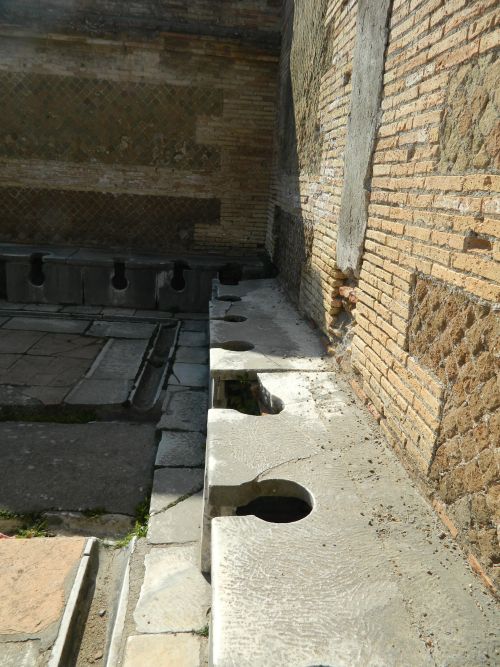
Figure 1: Public toilets from Ostia at the Forum baths.
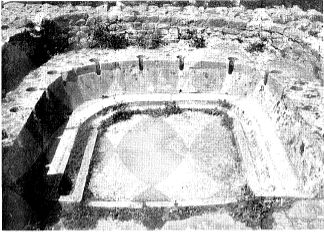
Figure 2: Excavated public latrine from Dougga.
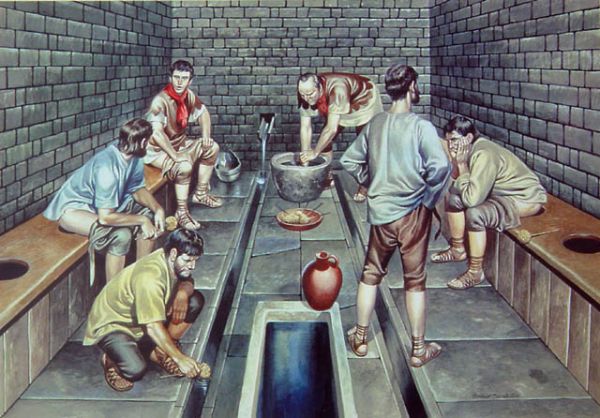
Figure 3: Public latrine at Housesteads Roman Fort, Britain.
Finding the foricae
So, how easy were these toilets to find? Rome is said to have had an extensive water system (Keenan, 2005), and these connected with the public toilets. Foricae could be easily found in the cities, near or even within public buildings, such as the bath houses and near the forum (Favro, 1997: 72). Archaeology has proven that public fountains were also key indicators of being close to a public toilet as the remains of plumbing systems suggest the water from drinking fountains and baths was reused to 'flush' the toilet blocks (Wilson, 2011: 99). Figure 4 shows a plan of the latrine at Dougga (See also Figure 2), where we can notice the proximity of the latrine to the fountain, indicating the point above. If these key indicators were not enough, the first-century BC philosopher Cicero wrote about the awful smell from these toilets and his desires to have them kept away from him (Hobson, 2009: 109). So not only are these toilets relatively well placed in the city to correspond with water networks, but their strong smell would also confirm their locality.
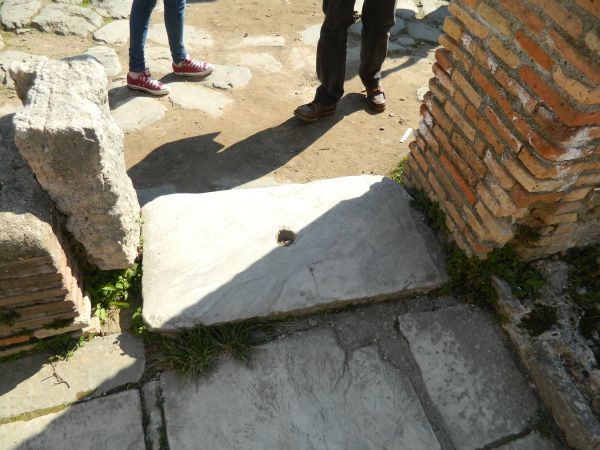
Figure 4: Ostia pivot hole from revolving door. Foricae at Ostia.
To enter these public toilets, much like today, users would in many cases have to pass through a vestibule or staggered entrance (Vaerenbergh, 2011). This would ensure privacy to those inside, protected from the view of passers-by. However, due to high demand for the use of toilets, many people relieved themselves in the vestibules. This can be seen by graffiti echoing phrases such as 'don't shit here' (Hobson, 2009). At the popular archaeological site of Ostia, an interesting and different style of ensuring privacy at the entrance of toilets is in place (Figure 4); a revolving door (Gallico, 2000). It appears to have been introduced to prevent people propping open the normal doors to ventilate the foricae[3], and consequently reducing their concealment (Vaerenbergh, 2011).[4] The interpretation that the doors were wedged open to ventilate the toilets at the cost of some privacy suggests that the users may not have been bothered by the privacy offered by the door, or perhaps that the ventilation was worth a reduction in privacy; however, the introduction of a revolving door at Ostia does suggest that privacy was required for the passer-by not to be able to peek into the toilets.
Literary Evidence: Using Martial's Epigrams to picture toilet behaviour
Having focused on the inner workings of these 'social hubs', it would be appropriate to address the written sources. However, these sources of evidence are very limited (Stambaugh, 1992) and those that are available tend to be very crude or mocking events occurring in the public latrines. This may be because, as today, using the toilet is a common thing not worth writing about, or if it was written about, not worth copying and translating for future generations. Nevertheless, these often exaggerated accounts can still offer some insight into what happened inside the public latrines. I have decided to look at two sources from the Latin poet Marcus Valerias Martialis (Martial), writing under the reigns of Domitian, Nerva and Trajan (AD 86 to AD103). The nature of Martial's epigrams was to mock his friends using sharp, crude wit and he often touched on social practices deemed unfit for other literary works of this time (Williams, 2004: 7). An interesting window into the social world of the Roman public latrine is given by Martial:
I advise you, if you are anxious to be read of, to look for some boozy poet of the dark archway who writes verses with rough charcoal or crumbling chalk which folk read while they shit. This brow of yours is not for marking with my brand.
(Martial XII.61)
This epigram is in response to Ligurra, a friend of Martial who wishes to be written about by the poet; however, Martial deems him unworthy of his work: 'this brow of yours is not for marking with my brand'. However, the most important piece of information than can be taken from this source is Martial's advice to Ligurra to find someone to graffiti about him in the toilets; no doubt 'while they shit' is a reference to a public foricae. This is interesting, as we might imagine those using the toilets could observe graffiti within them. Close observation of archaeological sites has revealed engravings of images and text on the toilet walls, and at Hadrian's Villa (in modern-day Tivoli) isotopic analysis has revealed traces of charcoal upon the walls (Molle, 2011: 176-77). This indicates a social atmosphere within the latrines; we might imagine users sharing a joke over the graffiti. Some comparison may be drawn with today's public bathrooms; however, the Roman foricae offered a more communal and, some might suggest, socially acceptable space to discuss the graffiti. If we remove the taboo of toilets that many of us hold today, so that there was no need for cubicle walls, then this might appear more normal. The interesting point here is not so much the potential gossiping, but rather the time of this taking place during the using of the toilet, whereas many of people today would reserve this for outside of the public bathroom. A humorous modern example of this was the Socchi 2014 Olympics, where some toilets were built, much like the Roman ones, without any dividing walls.[5]
This idea of toilets being used as a place for gossip and mockery is also indicated by the unpopular Emperor Tiberius (AD14-37) who banned his image being carried into the latrines, whether it was on a coin or a ring (Favro, 1997). But it is not only graffiti that would have made using the public foricae a socially interactive experience, as archaeologists have uncovered game boards etched between seats (Molle, 2011). Two users might have enjoyed playing a game while using the toilets. If we introduce the possibility of gambling taking place, as Purcell states that board games were particularly popular instruments in gambling (Purcell, 2004), we can add more depth to the social activities taking place in the foricae.[6]
Another text from Martial indicating the social nature of the latrines is this:
You read to me as I stand, you read to me as I sit,
You read to me as I run, you read to me as I shit.
(Martial III.44)
This particular passage, again satirical in its tone and nature, mocks the character of this epigram for shadowing Martial everywhere he goes reciting his work. The tone of the epigram could be read as ludicrous that Martial does not get any peace when he is using the toilet; however, this indicates the open and communal nature of the foricae. Care must be taken when using Martial as a source, as the nature of his work is to be exaggerative and often crude[7], but because of this the poet often plays on the mundane activities of everyday life deemed unworthy by other literary works.
This use of the exaggeration is probably best observed in the following passage, again from Martial:
Vacerra spends hours in all the privies, sitting all day long.
Vacerra doesn't want a shit, he wants a dinner.
(Martial XI.77)
In this passage, Vacerra is mocked by Martial for sitting in the toilets in the hope he will be invited to a dinner party. Dinner parties were a popular social occasion in Roman culture with their own social order convened by class (Brucia and Daugherty, 2007). Dinner parties were a key theme in Martial's Epigrams: the poet used these as settings to highlight bad behaviour and crude events in his poetry (Williams, 2004: 7). This passage mocks this cultural tradition and Vacerra is using the social accessibility of the public foricae to engage with fellow users in the hope to be invited to other social occasions. The fact that Vacerra sits in the toilets 'all day long' is an exaggeration from Martial, as although many toilets were adorned with marble and decoration, it is an absurd and comical notion. Nonetheless, this passage, like those above, from Martial indicates a social setting encapsulated in the Roman public foricae.
Evidence for special latrines and status in toilet use
As we have seen, the written sources are few and mostly crude or exaggerated for the expectations of the writer's audience. Therefore, most of our knowledge of Roman toilets derives from archaeological sources (Stambaugh, 1992). The archaeological evidence has mostly served our understanding of how they function (Hobson, 2009). However, there are some archaeological discoveries that indicate the availability of privacy for those who wanted it. As mentioned above, Cicero is noted to have asked that public latrines be kept away from him, showing that they were perhaps not in favour with those of his social position as senator and orator (Hobson, 2009), and Favro states that a better quality, and heated, latrine area was reserved for the senators in Rome, above the Forum. She indicates that this may have been relaxing spaces used for networking for the higher social classes (Favro, 1997: 72-73). There are many private toilets known in the Roman Empire. In the Jewish holy text the Mishnah, a 'Latrine of Dignity' is described (Magness, 2012):
There was a latrine of dignity, and that was its dignity.
If he found the door locked, he knew someone was in there,
If open he knew that no one was in there.
(m.Tamid 1:1)
This example is something familiar to us today, where the user can lock the door to ensure privacy. This particular toilet is one within a Jewish temple, and it reflects the religious status of the holy leader. The need for this private toilet is an exception to Roman culture due to stricter religious rules and regards for privacy in Judaism (Wilfend, 2009), where the act of defecation should not be seen by the eyes of God[8], hence the private latrine inside a religious building.[9] Although it is not only religious rules that regarded a level of privacy, as the archaeological record has shown. The location of public toilets appears to correspond with social status, as we will see with the following examples.
The first example of private latrines that appear to reflect status are those toilets reserved for the commanders at Roman forts (Goldwater, 2011). These were separate latrines to the communal ones reserved for the soldiers (Figure 5). Housesteads Roman Fort is home to best preserved Roman toilets in Britain.
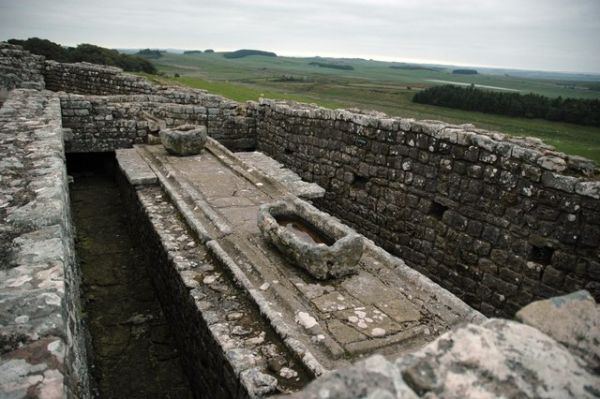
Figure 5: Communal latrines at Housesteads Roman Fort (see Figure1 for reconstruction).
The commander's quarters were reserved for the commander himself due to his social status and superior ranking in the army. Hoss and Thury state that in Judaism it is believed that shame would be brought upon a superior if he were to expose his genitals to an inferior (Hoss and Thury, 2011: 48). Therefore we may be witnessing a similar belief here, whereby a superior figure may need to compose his dignity due to his superiority. The same ideas can be seen at Hadrian's Villa in modern-day Tivoli. This is also a good example to use to compare the differences in latrine styles for different social status.
Villa Adriana: A re-evaluation of latrine styles and social status
Emperor Hadrian reigned from AD 117-138 and his villa, the Villa Adriana, served as a frequent alternative to the emperor's palace in Rome (Jansen, 2003) before becoming his permanent residence during his later reign. During this later period, Hadrian was joined at the villa by members of his court, and the differences in the latrine types correspond to the different social classes at the villa. Now a UNESCO World Heritage Site, the villa is an important archaeological site covering over 80 hectors (UNESCO, 2013), built as an ideal city for the Emperor himself (see Figure 6 and Figure 7). It is particularly interesting due to its number of latrines and their different styles. Figure 8 shows a map of the villa.
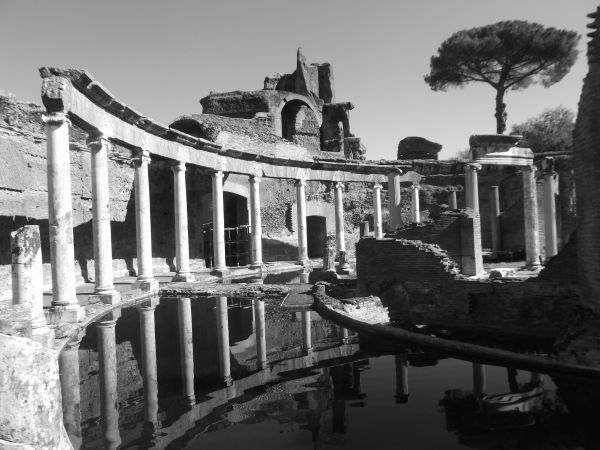
Figure 6: Hadrian's Villa.
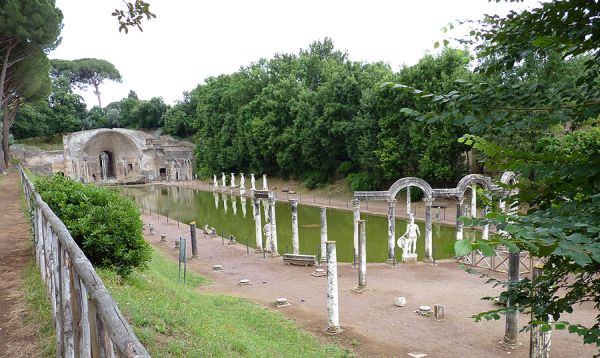
Figure 7: Hadrian's Villa.
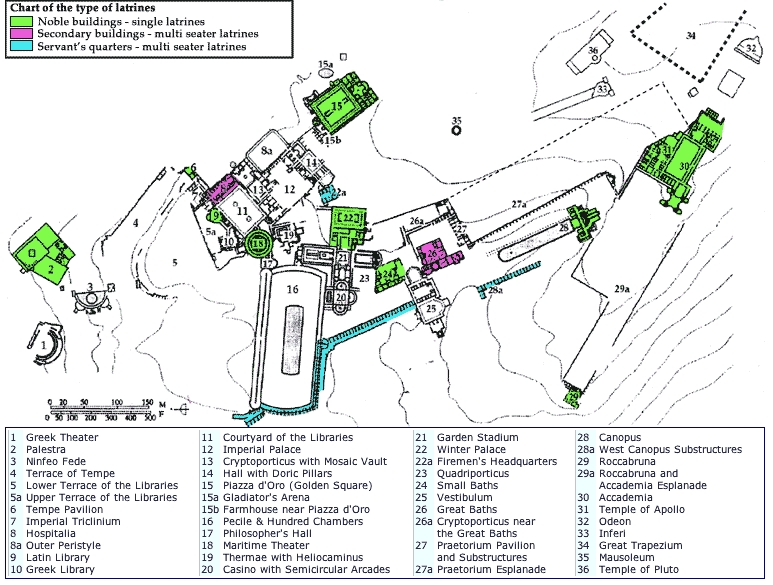
Figure 8: A plan of the Villa Adriana indicating latrine types (from Function and Meaning of Hadrian's Villa).
Figures 6, 7 and 8 show how grand and vast the villa was. So why, then, is there a need for different latrine styles? This is because within the villa, much like in the cities across the Roman Empire, there are different people of different social statures, who therefore require latrines with an appropriate level of dignity and privacy to their position in society. As can be seen in the Figure 8 the buildings highlighted green indicate the locations of single-seater latrines, offering the most privacy; purple indicates the high-status foricae (probably most like those used by senators in Rome), and finally blue indicating the much larger foricae most like those in Rome's public vicinity.
I would like to reassess this archaeological site, with the help of the map in Figure 8, as a microcosm for the relationship between status and latrine styles in the Roman world. If we look at the functions of the buildings that contain the single-seater latrines (green), we can see that these are most likely to have been reserved for the emperor and his family. These buildings are where we find the toilets offering the more private single seats (Figure 9), such as at the small baths (no. 26 on the plan) likely to have been reserved for the emperor's personal enjoyment. This becomes more likely when we compare this building with (no. 24) the great baths, highlighted purple, indicating a multi-seater latrine (Figure 10).These also offer more privacy and decoration than the latrines indicated in blue (De Franceschini, 2013) because archaeological evidence has suggested some form of divider between the seats to prevent those entering the latrines seeing those sat at the seat (Jansen, 2003). These divides are much like the dividing panels between urinals in some male toilets today. The level of decoration and the effort made to introduce some privacy to a multi-seater latrine suggests that this was for the entertainment of guests and the emperor's court. Other single seater latrines are found at the Emperor's Winter Palace (no. 22) and the Golden Square (Plaza d'Oro, no. 15) again indicating that these latrines were reserved for the emperor himself, with the most privacy.
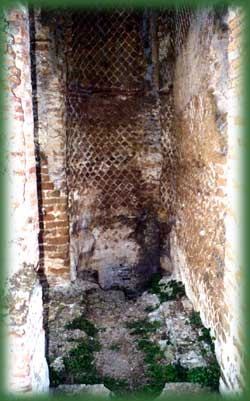
Figure 9: Single-seater latrine from Hadrian's Villa, Winter Palace.
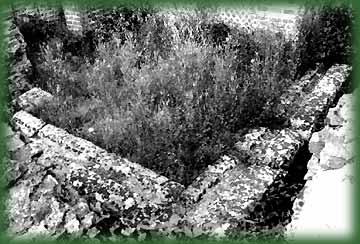
Figure 10: Multi-seater latrine from Hadrian's Villa (purple).
At the other end of the scale, if we observe the location of those latrines indicated in blue – the multi-seater latrines with the least privacy – they are found on the outskirts of the complex, away from any grand buildings. In fact, the multi-seater latrines correspond with (no. 16) the Hundred Chambers, where the villa's large numbers of servants, required to run the complex, lived (De Franceschini, 2013). Therefore, from this evidence we can assume that these multi-seated toilets with the least privacy were reserved for the servants, the lowest social status at the villa. This observation of the difference in toilet complex indicates a real segregation of classes in terms of the level of status and superiority. The emperor, at the highest level of superiority and status, is reserved the single-seater latrines; his guests have multi-seater latrines, with some privacy as they are smaller than the servants' latrines, and finally the lowest members of status and superiority, the villa's servants, have the largest latrines and the least privacy.
Summary
In conclusion, this article has looked at some of the evidence for Roman latrines and has attempted to present some possible scenes from within the toilets themselves. Through the microcosm of Hadrian's Villa we can see that toilet behaviour seemed to be dependent on social status: a desire for privacy and untarnished dignity in the segregation of superiors. We have also examined how this relates to the wider image of the Roman Empire itself. The assessment of Martial as one of the few literary sources for activity inside the latrines has proven that there was an aspect of social life in terms of gossip, graffiti and gaming indicating positive engagement among the users of the public foricae, although we must be careful when dealing with exaggerated or satirical content. Nevertheless, the archaeological evidence has served to present an environment in the public foricae of an unavoidable social atmosphere through the inward-facing seating arrangements and the lack of cubicle walls we are so familiar with today, but also the exploitation of this to create a social hub within the latrines. This research is far from conclusive and more interpretation and in-depth study of both written and archaeological sources is needed to develop our understanding of this aspect of Roman life.
Acknowledgements
I would like to thank all my friends, family and fellow students that have shown interest and support in the completion of this research. In particular I would like to thank Professor Kruschwitz and Professor Gardner for their help and encouragement.
List of Figures
Figure 1: Public toilets from Ostia, at the Forum Baths – Britten, 2010
Figure 2: Excavated public latrine from Dougga, photograph by Fikret Yegul. Taken from Favro, D.(1997) 'Roman Latrines' Places Journal 11(1) Berkeley, College of Environmental Design.
Figure 3: Reconstruction of Housesteads Roman fort latrines – English Heritage Postcard.
Figure 4: Ostia pivot hole from revolving door. Foricae at Ostia – Britten, 2010
Figure 5: Communal Latrines at Housesteads Roman fort from Geograph. Available at http://www.geograph.org.uk/photo/2768657 [accessed: 11/04/13]
Figure 6: Hadrian's Villa – Smithers, P, 2013
Figure 7: Hadrian's Villa from Historvius [online] Available at: http://www.historvius.com/hadrian-aeos-villa-21/pictures/650/ [Accessed: 11:04/13]. Reproduced with kind permission from Historvius.com.
Figure 8: A plan of the Villa Adriana indicating latrine types by and reproduced with permission of Marina De Franceschini from the website www.villa-adriana.net
Figure 9: Single-seater latrine from Hadrian's Villa, Winter Palace. Available at:http://www.villa-adriana.net/pages/eng/page9_3.html#grp5 [Accessed: 27/02/2013]. Photo by and reproduced with permission of Marina De Franceschini from the website www.villa-adriana.net
Figure 10: Multi-seater latrine from Hadrian's Villa. Available at:http://www.villa-adriana.net/pages/eng/page9_3.html#grp5 [Accessed: 27/02/2013]. Photo by and reproduced with permission of Marina De Franceschini from the website www.villa-adriana.net
Notes
[1] Matthew Britten is a student in the Department of Classics at the University of Reading.
[2] This can be seen in things such as the children's show Horrible Histories, producing sketches set in Roman toilets. Publicly this can also be traced through prominent news stories related to Roman latrines, such as the reclassification of potsherds from Fishbourne as 'toilet paper' (see http://www.bbc.co.uk/news/uk-england-21204228). In terms of the academic literature, increased interest can be seen in the extensive multi-disciplinary approaches that have reached publication in recent years.
[3] Ventilation is an interesting issue to try and reconstruct. It is difficult to know how much ventilation there would have been. Some scholars have suggested that ventilation was offered by open ceilings, which seem likely to have been part of the architecture of the foricae. However, the author's personal experience of visiting Herculaneum and Pompeii and seeing the open-ceilinged atriums indicates that they are often very warm and lack a consistent flow of air. No matter how much improved ventilation was offered from a potential open ceiling, opening the door would seem to be the only option.
[4] There is some debate about this being a revolving door, but the consensus is that it is.
[5] See http://blogs.reading.ac.uk/latin/2014/02/08/an-olympic-shitstorm/
[6] Although this is purely speculative.
[7] For a more in-depth appreciation of the available sources for toilets in antiquity see Hobson, 2009: 133-47.
[8] For a further discussion of toilets in Judaism see Jodi Magness, Stone and Dung, Oil and Spit: Jewish Daily Life in the Time of Jesus (Grand Rapids, MI: Eerdmans, 2011), Chapter 10, 'Toilets and Toilet Habits'.
[9] Most Jews would also have used the public foricae; we know this by a passage from Seneca depicting a Rabbi being removed from his seat by a Roman soldier, before the soldier is bitten by a snake.
References
Primary sources
Martial, Epigrams (1993), trans. Bailey, D. R. S., Loeb Classical Library (London: Harvard University Press)
Mishnah (1988), trans. Nuesner, in Magness, J. (2012) 'What's the poop on ancient toilets and toilet habits?', The Journal of Near Eastern Archaeology,75 (2), 80-87
Secondary sources
Brucia, M. and G. Daugherty (2007), To Be A Roman: Topics in Roman Culture (Illinois: Bolchazy-Carducci)
De Franceschini, M. (2013), 'Building classification in Hadrian's Villa', available at http://www.villa-adriana.net/pages/eng/page9_3.html, accessed: 11 April 2013
Favro, D. (1997), 'Roman Latrines', Places Journal, 11 (1),
Gallico, S. (2000), Guide to the Excavations of Ostia Antica with a Section About the Renaissance Borgo (Rome, ATS Italia Editrice)
Hobson, B. (2009), Latrinae et Foricae: Toilets in the Roman World (London, Duckworth)
Hoss, S. and G. Thury (2011), 'Jewish and Christian Texts on Ancient Latrines', in Jansen, G., A. Koloski-Ostrow and E. Moormann (eds), Roman Toilets: Their archaeology and cultural history, Babesch Annual Papers on Mediterranean Archaeology, supplement 19 (Leuven: Peeters), pp. 48-
Jansen, G. (2003), 'Social Distinctions and Issues of Privacy in the Toilets of Hadrian's Villa', Journal of Roman Archaeology, 16, 137-
Keenan, D. (2005), Water Supply and Wastewater Disposal in Pompeii: An Overview, Macquarie Ancient History Association, available at http://www.researchonline.mq.edu.au/vital/access/services/Download/mq:6052/DS01?view=true, accessed 25 January 2013
Laurence, R. (2010), Roman Passions: A history of Pleasure in Imperial Rome (London: Continuum Publishing)
Magness, J. (2012) 'What's the poop on ancient toilets and toilet habits?', The Journal of Near Eastern Archaeology, 75 (2), 80-87
Molle, C. (2011), 'Case Study: Graffiti in a Toilet at Hadrian's Villa', in Jansen, G., A. Koloski-Ostrow and E. Moormann (eds), Roman Toilets: Their archaeology and cultural history, Babesch Annual Papers on Mediterranean Archaeology, supplement 19 (Leuven: Peeters), pp. 176-
Purcell, N. (2004), 'Literate games: Roman urban society and the game of alea', in Osborne, R. (ed.), Studies in Ancient Greek and Roman Society, Past and Present Publications (Cambridge: Cambridge University Press) pp. 177-205
Scobie, A. (1986), 'Slums, Sanitation and Morality', Klio, 68 (2) 399-433
UNESCO (2013), 'Villa Adriana (Tivoli)', available at http://whc.unesco.org/en/list/907, accessed 11 February 2013
Vaerenbergh, J. (2011), 'Location of toilets within baths', in Jansen, G., A. Koloski-Ostrow and E. Moormann (eds), Roman Toilets: Their archaeology and cultural history, Babesch Annual Papers on Mediterranean Archaeology, supplement 19 (Leuven: Peeters), pp.115-18
Wilfend, Y. (2009), unpublished work. In: Hoss, S., and Thury, G. (2011) 'Jewish and Christian Texts on Ancient Latrines'. In: Jansen, G., A., Koloski-Ostrow and E., Moormann, (eds.) (2011) Roman Toilets: Their archaeology and cultural history. Babesch Annual Papers on Mediterranean Archaeology, supplement 19. Lueven: Peeters.p.48.
Williams, C. (2004), 'Introduction, Translation and Commentary', in Martial, Epigrams (New York: Oxford University Press), pp.
Wilson, A. (2011), 'Toilets', in Jansen, G., A. Koloski-Ostrow and E. Moormann (eds), Roman Toilets: Their archaeology and cultural history, Babesch Annual Papers on Mediterranean Archaeology, supplement 19 (Leuven: Peeters), pp. 99-104
To cite this paper please use the following details: Britten, M. (2014),'Don't Get the Wrong End of the Stick: Lifting the Lid on Roman Toilet Behaviour', Reinvention: an International Journal of Undergraduate Research, Volume 7, Issue 1, http://www.warwick.ac.uk/reinventionjournal/issues/volume7issue1/britten Date accessed [insert date]. If you cite this article or use it in any teaching or other related activities please let us know by e-mailing us at Reinventionjournal at warwick dot ac dot uk.